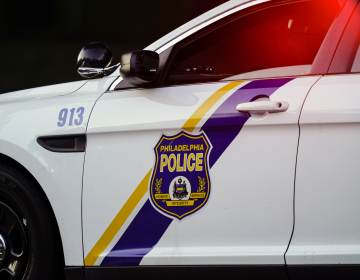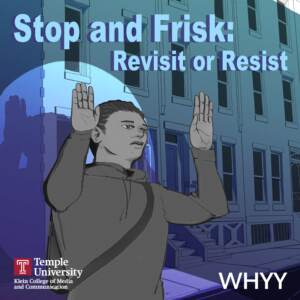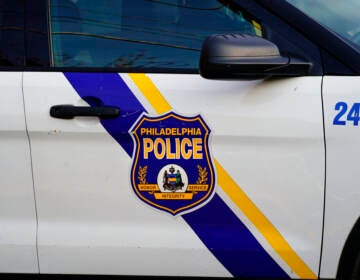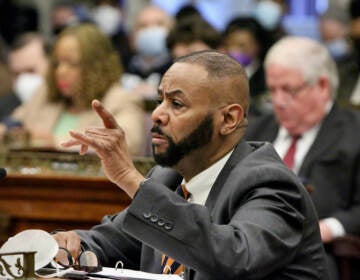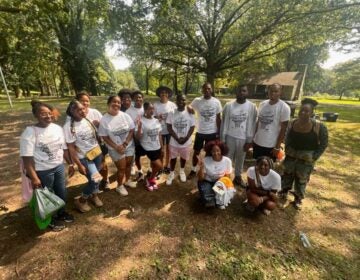Behind stop and frisk: The history, the controversy, the findings
Philly City Council members reignited the debate on stop and frisk as a solution to the city’s gun violence crisis, raising questions about what makes residents feel safe.

Paul T. Jackson, 34, works with Frontline Dads patrolling the area around Broad and Susquehanna at dismissal time to look out for potential violence. His own experience with stop and frisk makes him think it is not a good idea. (Emma Lee/WHYY)
This story is from Stop and Frisk, a podcast production from WHYY News and Temple University’s Logan Center for Urban Investigative Reporting
Find it on Apple Podcasts, Spotify, or wherever you get your podcasts.
How do you feel about stop and frisk (and policing more broadly) as an answer to Philly’s gun violence crisis? Get in touch
From 2007 to 2021, there were 5,478 homicides in Philadelphia, according to city data. That’s an average of about one person killed every day for 14 years.
Though only 40% of city residents are Black, the bloodshed has inordinately impacted Black and historically redlined neighborhoods that have high poverty and unemployment rates.
In 2020, the City Council authorized the formation of a multi-agency effort to review the city’s surge in homicides and gun violence. The 100 Shooting Review Committee’s report, produced in collaboration with the police department, public health department, district attorney’s office, and the public defender office, included 27 recommendations to stymy killings and reduce the number of illegal firearms coming into the city. The ideas range from increasing victim relocation services to creating a philanthropic public safety fund to planting trees on blighted streets.
The committee’s analysis of the city’s gun violence underscores the problem as a “racial justice crisis.” Since 2015, roughly 80% of shooting victims and shooting-related arrests have been Black men, mostly ages 18-35.
In the 16-month span from the committee’s authorization in September 2020 to the January 2022 release of their report, 837 people were killed in Philadelphia, according to a WHYY analysis of city data.
This summer, City Council members were again driven to urgently address gun violence.
Just days after a shooting at an Independence Day festival wounded two police officers and left hundreds running for cover, City Council members held a special session on solutions to gun violence, which included discussions about stop and frisk.
City Council President Darrell Clarke resurfaced using the controversial policing practice.
“It needs a different name, right? … Because the reality is, that when you reference stop and frisk it has a negative connotation,” he said. “And the bottom line is, it should be a part of the policing strategy that’s employed.”
The backlash was immediate. Mayor Jim Kenney spoke out against the idea, as did District Attorney Larry Krasner. Councilmembers Jamie Gauthier, Helen Gym, and Kendra Brooks wrote a letter denouncing Clarke’s suggestion.
“We need to be aggressive and courageous in our approach to gun violence prevention, but that doesn’t mean repeating the mistakes of our past,” the letter reads. “To heal relationships, prevent future shootings, and save lives, Philadelphia must resist reverting to a failed past.”
This isn’t the first time a Philly politician has endorsed the practice. Former Mayor Michael Nutter made stop and frisk a talking point during his 2007 campaign, and still thinks the policing tactic can be part of Philadelphia’s gun violence reduction strategy.
There are residents who want to see a version of stop and frisk return, too.
At an October gun violence march, activist Eric Allen, who is in his fifties, said he wants to see the policy applied to young people standing outside of businesses.
“They should be stopped, they should be frisked,” Allen said, striding down Broad Street with a megaphone at his side and his toddler nephew on his shoulders. “If it’s not a library or educational institution, you shouldn’t be hanging out anyway.”
Temple University freshman Jerome Richardson, marching a short distance away from Allen, could easily be subjected to such a stop.
“We talk about some of the sort of tactics that are used to demoralize humans, especially Black bodies,” said Richardson. “We have a history of being killed, being murdered, and being profiled.”
The generational divide around stop and frisk speaks to the conundrum of policing in Philadelphia— that what makes one resident feel safe can make another feel like a target, and the line between protecting residents and penalizing them is dangerously thin.
It’s a puzzle some city leaders have set out to solve in the lead-up to the 2023 mayoral election. Gauthier says the conversation is a reflection of the moment, and a failure to look at the root causes of the crisis.
“It’s scary to have record levels of gun violence … breaking out at all times of day, regardless of whether there are children or elderly people or pregnant women around,” she said. “People want to see the city have a serious, visible approach that they understand to addressing gun violence. And I think that comes out as people calling for stop and frisk because they’re scared.”
Stop and frisk: A legal history
Stop and frisk has been used in Philadelphia for decades, and legal scholars say it’s never truly ended. The practice was formally established in the 1968 U.S. Supreme Court case Terry v. Ohio. It gives police officers the legal authority to stop someone if they have “reasonable suspicion” they have committed, are committing, or are about to commit a crime. Police can frisk that person under a separate legal criteria, if they have reasonable suspicion to believe the person is “armed and dangerous.” A frisk is a pat-down, and is not supposed to involve searching a person’s bags or other items.
The practice was vigorously used during the ’90s and 2000s. Former Philadelphia Mayor Michael Nutter leaned into the strategy, arguing that more aggressive policing would lower the city’s homicide rates.
By 2009, the Philadelphia Police Department was conducting more stops per capita than any department in the country, according to an ACLU report. The ACLU also found that though Black and Latino residents comprised approximately 50% of the City’s population, they accounted for nearly 90% of stops
Back then, no one was monitoring the stops and whether officers had reasonable suspicion to conduct them, said attorney and University of Pennsylvania criminal justice scholar David Rudovsky. But, personal accounts and records show officers were disproportionately stopping Black men, mostly for petty offenses, and were rarely seizing illegal guns.
“It’s more than racial disparities, it’s racial bias patterns,” Rudovsky said. “When you try to examine it and see if there are nonracial reasons for the disparities, the nonracial reasons don’t explain them.”
In 2010, Rudovsky and the ACLU of Pennsylvania successfully argued a lawsuit against the city of Philadelphia. The settlement made it illegal for officers to stop people based on race.
That lawsuit also resulted in the Bailey Agreement, which required the Philadelphia Police Department to create an electronic database of all stops and frisk encounters. Additionally, the Bailey Agreement established a panel of legal experts to assess whether those stops were made with reasonable suspicion, and mandated the police department provide training to teach officers about racial bias.
The lawsuit didn’t ban stop and frisk, also referred to as a Terry stop. But, it did mean that officers had to start proving they had reasonable suspicion to detain someone, and that the decision wasn’t based on race.
But, assessing whether a stop was lawful is easier said than done.
“With a bad stop, you can bring the officer in and say, ‘Look, you didn’t have reasonable suspicion,’” said Rudovsky. But, “How do you know any individual stop was racially biased or not? Right? It’s impossible to know.”
As Philadelphia attempted to implement the Bailey Agreement, other cities were grappling with their own stop and frisk decisions. In 2013, a New York court found the implementation of the practice in New York City unconstitutional. Mayor Jim Kenney took office in 2015, he vowed to eliminate the practice. He later walked back his position, explaining that he only wanted to prevent police from racially profiling Philadelphians.
The number of stops did go down during his tenure. In 2017, total stops were about half of what they were in 2010, according to Rudovsky.
Racial bias persisted though. In the second half of 2019, Black Philadelphians made up 71% of stops despite comprising only 44% of the population, according to a 2020 ACLU report, and about a third of frisks were still happening without reasonable suspicion.
Weighing personal well-being against public safety
Clarke has since backed away from his statement of support for stop and frisk, and City Council hasn’t held any other formal discussions about it. But the stop and frisk discussion continues to ripple through communities most directly impacted by violence.
At an August community meeting in South Philly’s Grays Ferry neighborhood, a few dozen residents met in a Catholic school gymnasium to discuss stop and frisk, and public safety more broadly. Attendees were mostly people over age 40 — a mix of neighborhood residents, community group directors, and law enforcement representatives.
Many who spoke at the podium expressed a desire for more police presence in the neighborhood, and a few thought stop and frisk might be a helpful strategy if officers could be trained to do it in ways that aren’t harmful.
Reuben Jones, executive director of gun violence prevention group Frontline Dads, pushed back against that stance.
“We all want to see the gun violence end, but stop and frisk is not the way to do that,” he said.
Jones pointed out officers rarely find guns during these stops. During the second half of 2019 only one firearm was found for every 100 frisks, according to an ACLU analysis. The seizure rate is improving though. In the first quarter of 2022, guns were recovered in 5% of stops and 8% of frisks, according to attorney Rudovsky.
“Let’s work together on some common sense solutions that keep all of our families safe without contributing to mass incarceration,” Jones said. “Because the more officers get deployed in your community, the less freedoms you’ve got.”
What’s the harm?
For some Black Philadelphians’ concerns about stop and frisks go beyond encounters with police leading to unlawful arrest or detainment. Rather, it’s a matter of life and death.
Police use of force is the sixth-leading cause of death for young men of color nationwide, according to a 2020 study from the University of Michigan, Rutgers, and Washington University. About 100 in 100,000 Black men and boys will be killed by police annually.
Many police murders of Black men, such as George Floyd and Michael Brown, began with a Terry stop.
Tyrone White, 23, lives in West Philly, one of the city’s gun violence hot spots. He said his parents talked to him from an early age about how to conduct himself calmly around the police. He said he’s still afraid that encounters with them will turn violent, no matter what he does.
“With every situation that we’ve seen, it started off with something small, like cigarettes, or just being at the wrong place at the wrong time, or running a red light,” he said. “Those things can escalate very quickly…I’ve seen videos where white people have been just completely defiant, holding knives and just doing all type of stuff… If that was a Black person, they would have never gotten away with that.”
Philadelphia has taken active steps to decrease hostile interactions between police and residents. As a result of the 2010 lawsuit that changed the way stop and frisk is handled in Philadelphia, there are now six pilot districts where law enforcement officers are instructed to make verbal requests – not formal stops – for minor offenses such as drinking, smoking marijuana, or urinating in public. If the person does not comply, the officer can then detain them, according to the ACLU of Pennsylvania.
As of this year, police officers can’t stop a vehicle for a broken taillight, an expired license plate, or other violations under the Driving Equality Act recently passed by City Council. Those offenses would be addressed by other means instead.
One of the goals of the new policies, according to the ACLU, is to reduce how often police officers and civilians are interacting, in hopes of minimizing the chance of something escalating to violent conflict.
It was a traffic stop that led to the police killing of David Jones, a 30-year-old Black man stopped for driving his dirt bike illegally. Jones was armed, but he dropped the gun when he started running away from Officer Ryan Pownall with his hands in the air. Pownall shot him twice in the back, and a judge recently dismissed all charges, including murder, after the judge determined the district attorney’s office failed to follow proper pre-trial procedures. “Our office respectfully disagrees with the judge’s dismissal of all charges against former Officer Ryan Pownall for his on-duty killing of an unarmed Black man in the back,” said Jane Roh, district attorney spokesperson.
Tommy Jones and Gloria Davis are still carrying the weight of their son’s death.
“He’s missed birthdays, holidays, graduations,” Davis said. “We had a son graduate. He wasn’t there… He’s got nieces he didn’t get to meet, nephews.”
Yet, even Jones’s parents believe there are times when stop and frisk could be helpful.
“It’s good in some ways and then bad in another,” Jones said. “You could pull people over before they go and commit a crime or do something stupid with a firearm or whatever the situation may be. You can eliminate that by stopping them, catching them right in the act before they do something and either take them off the street or take the firearm or whatever.”
Does stop and frisk make us safer?
Some Philadelphians who support stop and frisk believe that it will help police confiscate firearms that would otherwise be used in shootings. Some feel that even if it doesn’t, it could restore a sense of lawfulness to neighborhoods where crime is rampant.
“A part of it is changing the culture and changing the mindset,” said Nutter in October. “I wanted people to stop carrying these weapons…I think some people heard that message. I’m not saying they stopped completely, but they may be carried less often.”
During Nutter’s time in office, homicides did decrease. The homicide tally dropped by roughly 23% from 2007 to 2009, giving many people the perception that the tactic was reducing crime.
But when Kenney took office in 2015 and cut back on stops, crime didn’t rise dramatically. The major spike in gun violence didn’t begin until 2019, and it worsened during the sustained period of socioeconomic instability following the COVID-19 pandemic.
“You had two or three years where even with reduced stops … it was still a pretty low plateau,” said attorney David Rudovsky. “A lot of people think it ended and that’s why we’ve got this surge in murders. And, that’s just not true.”
Nutter said crime was low during his time as mayor because of policing initiatives he instituted with help from former police commissioner Charles Ramsey. These included strategically deploying officers to areas where gun violence was most frequent, adding officers on foot and bike patrols, installing surveillance cameras on high-crime streets, and establishing tip lines to solicit leads on cases, he said.
When it comes to stop and frisk, Nutter said “mistakes were made” during his term, but he still sees promise in the practice.
“Some people crossed the line and were or should have been appropriately disciplined,” he said. “I’m not for the abuse of our citizens. We’re not going to break the law to enforce the law.”
He said to do this right, police departments need to ramp up supervision and oversight.
“Monitoring what the officers are doing, how they do it, reminding them literally of the Constitution and the provisions of that particular Supreme Court ruling,” he said. “That’s where we fail.”
Sgt. Michael Spicer with the Philadelphia Police Department said stop and frisk is a tool in law enforcement’s toolbox, but that officers are much more intentional about how they use it now. Spicer was one of six officers who in 2012 was charged with beating up drug dealers, stealing their money, and then filing false police reports. He was acquitted in 2015 and then promoted to sergeant.
Spicer said if they’re in an area where guns are prevalent and they suspect someone is carrying, they’ll start with a “mere encounter.” This is an officer approaching someone without formally detaining them.
“But, a lot of times, because the person that is illegally carrying that gun reacts, meaning they run or they throw [the gun], that leads to arrests,” he said.
The Philadelphia Police Department doubled the number of guns it has confiscated since 2017, but arrest rates haven’t translated to a drop in gun crime. Firearms are also more accessible than ever due to Philadelphia’s inability to pass stronger gun laws and the proliferation of “ghost guns,” which people can order online and assemble.
There is a lack of evidence for stop and frisk as a crime reduction tool. There is concern, however, from criminal justice experts that the practice sows distrust in law enforcement. People less likely to come forward when they have information presents a barrier to solving crimes.
“Better investigation strategies and tactics, those are the kinds of things that make a difference,” said Lenore Anderson, executive director of the Alliance for Justice and Safety, a national organization that fights over-incarceration, and author of a new book about mass incarceration. “These sort of sweeping approaches where you stop everybody and frisk everybody…those things are bad public policy.”
Dana Amihere contributed to this report.
Correction: A previous version of this story misstated the number of Black men and boys killed by police annually. Also, the judge in Officer Ryan Pownall’s case recently dismissed all charges against him, including murder. An earlier version of this story stated Pownall was cleared of all charges. The story has been updated.
Editor’s note: This story has been updated to include the organizations behind the 100 Shooting Review Committee report, as well as additional information about stop and frisk, the ACLU pilot program, the Driving Equality Act, and the criminal record of Sgt. Michael Spicer.
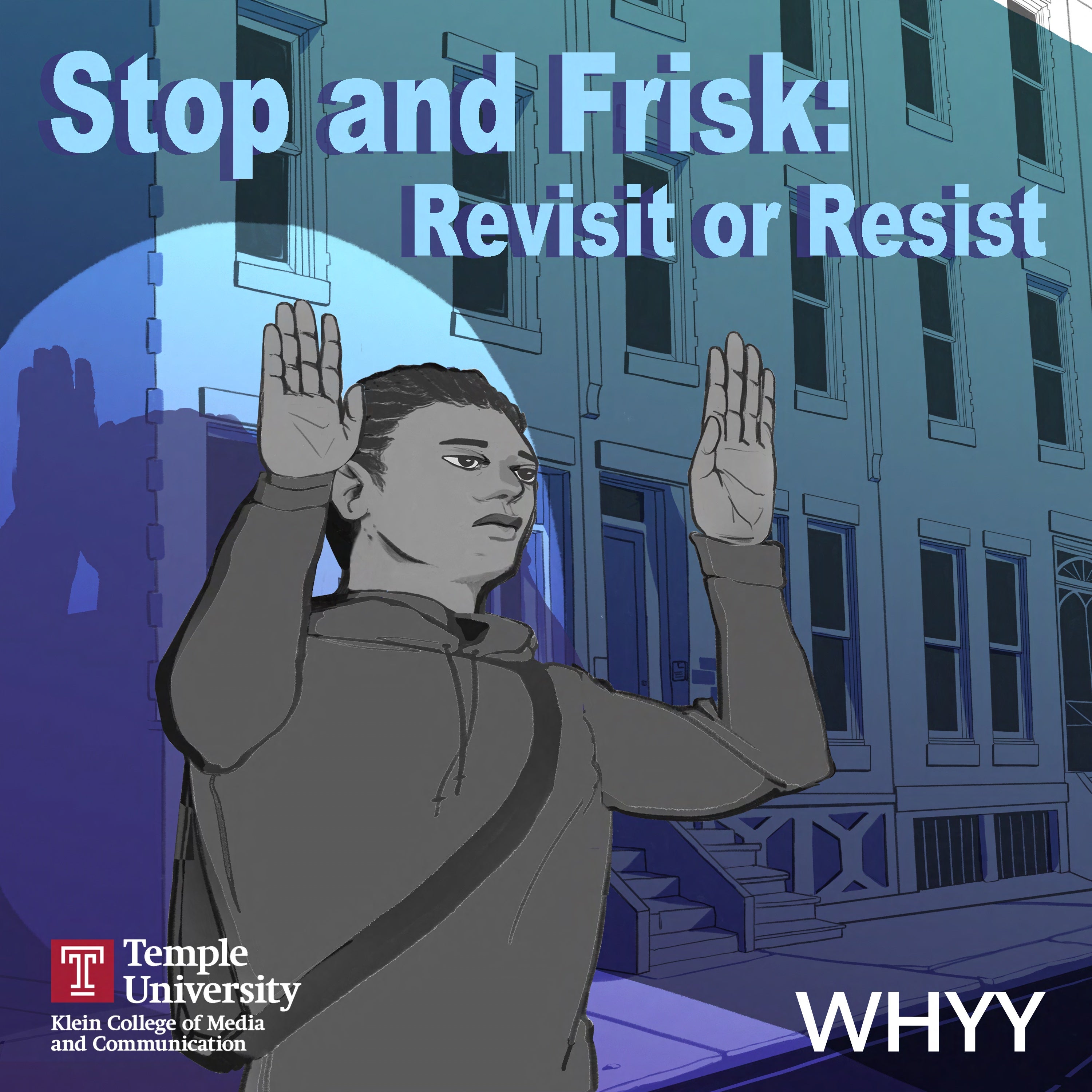
Stop and Frisk: Revisit or Resist
WHYY is your source for fact-based, in-depth journalism and information. As a nonprofit organization, we rely on financial support from readers like you. Please give today.


